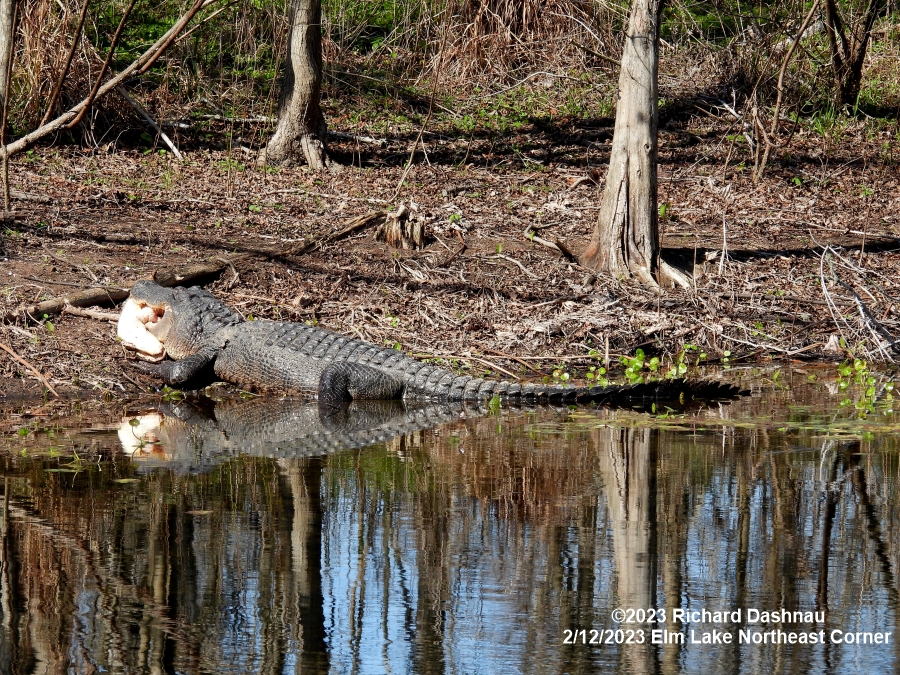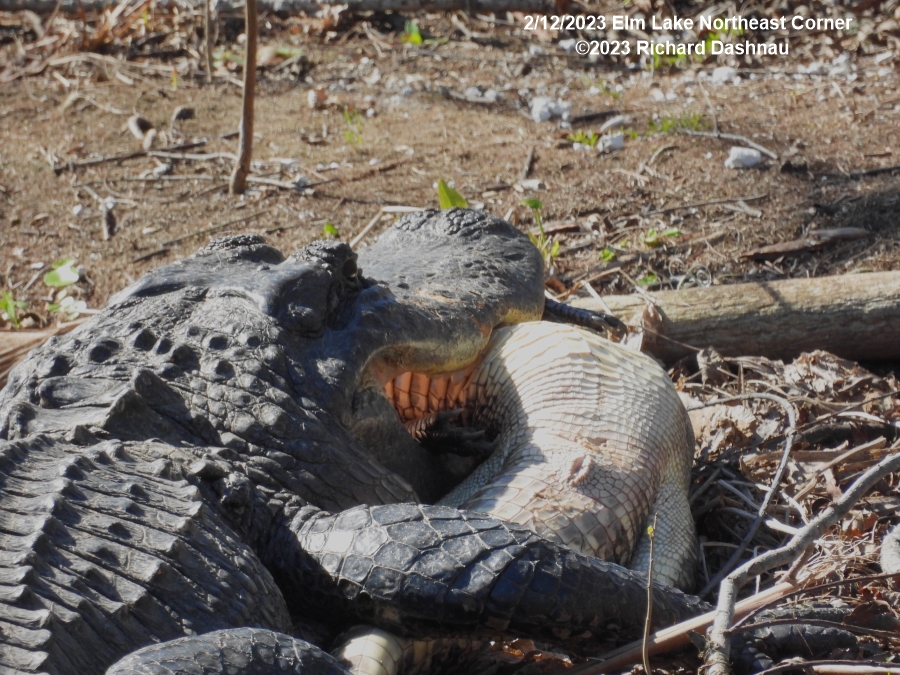The bellows were only repeated twice, so I had trouble catching up to the gator. A couple small gators bellowed closer, but I passed them because I wanted to find the
male that was bellowing so loudly. There was a large gator at the edge of Elm Lake, about 20 yards North of the end of the Spillway Trail. It wouldn't bellow while I was
watching and waiting. While I waited for it to bellow again (it didn't), I heard what seemed to be violent splashing from many yards away. I thought it could have been Coots
arguing. And then I heard it again. And again. Each time, there were just a few splashes, then silence. I thought it might signal some kind of alligator activity, but I wanted
to see this gator bellow. (It didn't.) After one of those splashes, the large gator I had been watching seemed to respond. It turned towards the sound, started moving North
and submerged under the mats of hyacinth. All of the events I describe here are also shown in this edited video.





I looked for the splashing. I thought the big gator might head that way too--but I didn't see it. I walked carefully. If splashing was an alligator with prey, or alligators fighting,
or alligators fighting over prey--then one or more alligators trying to leave the situation might suddenly appear in front of me on the trail.
I found two alligators locked together. Both were at least 6 feet long. One had its jaws clamped tightly over the head of the other and they were right next to the bank. At first
I thought that one of them was dead. But they were both active. As is usual when an alligator has its jaws clamped on something, there were periods of relative stillness, with
brief periods of quick and violent action. They can drown prey, but drowning another alligator could be difficult. Then the submerged gator moved, and pulled against the
one above. The lower one was anchored on the shore, while the other one was partially floating. So, there were two live alligators for sure. What was going on?





When the alligators thrashed again, I could see that each alligator had its jaws clamped on the jaw of the other. That is, one alligator had both jaws clamped on the upper jaw
of the other--while the other had both jaws clamped on that one's bottom jaw. Sometimes an alligator will "thrash" a carcass, by violently shaking it side-to-side, or by pulling
it with a sharp jerk. If the prey is small enough, it is lifted and cracked like a whip until it breaks into pieces. One or both gators lifted and thrashed. Since both sets of jaws
were clamped together, there wasn't much damage. Please note that I am shooting with telephoto/zoom functions on the camera. I'm at least 20 yards away from the alligators
I show here. There was also another gator grunting/croaking from the West side of the trail (which was behind me), so I watched that side also--I couldn't see that gator.





Twist feeding (rolling) is a reflexive action that alligators do when their jaws encounter resistance. It can be used to drown or subdue live prey, or pull pieces from a large
carcass. Here, both alligators could use the technique--and could work against it. They both seemed to be about the same size, so were evenly-matched. When twist-feeding
in open water the tail is used by twisting angled to the main axis of the body. ("Death roll of the alligator: mechanics of twist feeding in water" by Fish, Bostic et. al. 2007)
In shallow water, or on land, the tail used as a bit differently. Here, neither gator could generate power; and each interfered with the twisting of the other. There seemed to be
some "cracking" sounds. It could have been from hard surface contact, or possible stress in the skull and jawbones. Both gators remained stoic throughout this conflict. This
stoic, deliberate approach to survival is one of the things I admire when I watch alligators. I show some old examples of twist feeding and prey thrashing on this page.





I thought I was scheduled to work at the Nature Center, and it also looked like it was going to rain soon--so I couldn't watch for very long. I hoped to see a resolution to this
conflict with neither alligator seriously harmed, but was very curious how this would end. I've seen other conflicts like this resolve in a draw. While I watched this apparent
stalemate, I also wondered what had started this. I will never know for sure. The alligators have never told me what they're up to.





My desire for a quick and nonviolent resolution soon fulfilled--but in a very surprising way. An alligator larger than the two combatants (probably the one I'd been watching
earlier) surfaced from under the hyacinth. It cruised slowly towards the two combatants. It maintained this majestic pace until it was within touching distance of the two.





The "top" gator quickly opened its jaws (upper jaw was lifted off the other's head), but could not disengage because its lower jaw was still trapped by the other alligator.





When the Big Gator moved in and gave a gap-jawed nudge to the two heads, the "bottom" gator released its grip. Then one quickly moved away and swam to the deeper water,
while the other moved towards the bank. The rapid movement indicated in the images below is only from the retreating alligator as it moved to the deeper water.





The Big Gator moved away from the one near the bank, and turned to face the gator in the water, as if to guard the gator on the bank. The other alligator kept moving away.
The Big Gator turned around and moved towards the one at the shore, as if to guide it to the bank, and watched it climb onto land. The Big Gator moved slowly, with no
apparent aggression. It seemed like the big gator had been protecting the alligator on the bank. I had to leave, so I couldn't see what else happened. I have recorded two
other examples of alligator conflict: In 2012, I found two alligators that had grabbed each other by the hip. I show another fight from 05/09/2022 further down on this page.
































